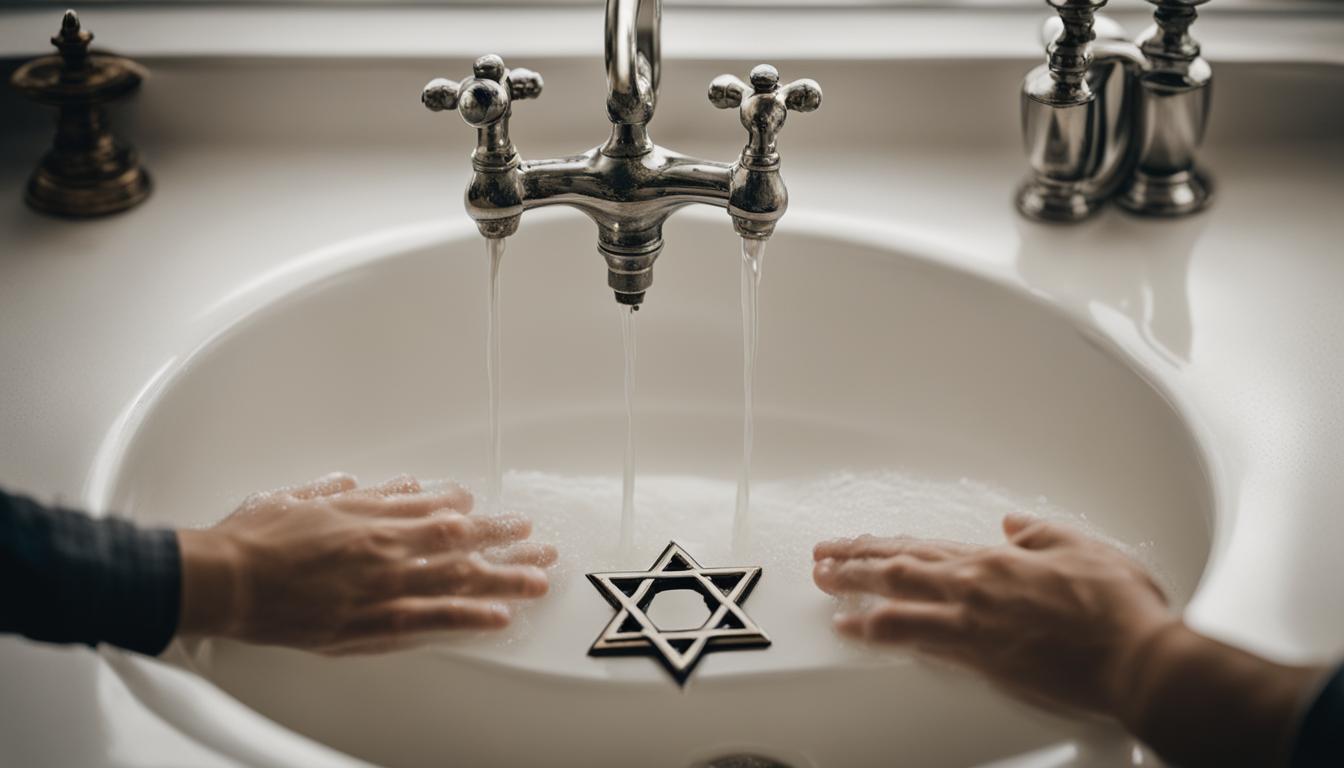Ablution, also known as “tevilah” in Hebrew, holds great significance in Jewish tradition. It is a ritual practice performed to restore ritual purity and enable individuals to partake in certain rituals and functions. While it is not meant for personal hygiene purposes, it plays a crucial role in ensuring cleanliness and spiritual purification in Judaism.
Ablution is mentioned in the Hebrew Bible and continues to be observed in various forms within Orthodox and Conservative Judaism. It is a practice deeply rooted in historical and cultural contexts, with its origins in ancient religions. Ablution in Jewish tradition involves three types: complete immersion, immersion of hands and feet, and immersion of hands only.
Key Takeaways:
- Ablution, or “tevilah,” is a ritual practice in Judaism for achieving ritual purity.
- It is not meant for personal hygiene purposes but allows individuals to partake in specific rituals and functions.
- There are three types of ablution in Jewish tradition: complete immersion, immersion of hands and feet, and immersion of hands only.
- Ablution has historical and cultural significance, with its origins in ancient religions.
- Orthodox and Conservative Judaism continue to observe ablution, while Reform Judaism generally does not.
Historical and Cultural Significance of Ablution in Judaism
Ablution, or ritual washing, has played a significant role in Jewish traditions throughout history. This practice holds a deep historical and cultural significance, rooted in ancient religious practices and customs. Ablution can be traced back to ancient civilizations such as Egypt and Greece, where purification rituals were common.
In Judaism, ablution serves as a means of spiritual cleansing and achieving ritual purity. It is performed for various purposes, including preparation for participating in Temple services, eating “holy” food, and even for conversion to Judaism. The mikveh, a specially designated body of water, is a central element in Jewish ablution practices. It is considered a sacred space for individuals to immerse themselves and purify their souls.
The Importance of Mikveh in Jewish Tradition
The mikveh holds a unique place in Jewish tradition as a symbol of spiritual rebirth and renewal. It is used for various life events, such as after menstruation, childbirth, and conversion. The act of immersing oneself in the mikveh represents a ritualistic transformation, where the individual emerges cleansed and purified, ready to engage in spiritual practices and observances.
By immersing in the mikveh, individuals connect with their spiritual selves and reaffirm their commitment to Jewish values and traditions. It is an essential practice that underscores the significance of spiritual purity in Judaism and provides a sense of spiritual wholeness and renewal.
Types of Ablution in Jewish Tradition
In Jewish tradition, ablution plays a significant role in achieving purification and ritual cleanliness. There are three main types of ablution that are practiced in Judaism, each serving a specific purpose. These types of ablution are based on the level of impurity involved and the specific requirements outlined in the Torah.
Purification Through Immersion
The first type of ablution is complete immersion, which requires the person or object to be purified to undergo total immersion in “live water” such as a spring, river, sea, or a mikveh. This type of ablution is necessary for cases of ritual impurity decreed in the Torah. Immersion in the mikveh, a specially designated body of water, is a common practice among Orthodox and Conservative Jews for achieving purification.
Immersion of Hands and Feet
The second type of ablution is the immersion of hands and feet, which was required for priests before participating in Temple services. This practice ensured that they were in a state of purity before engaging in sacred rituals. Although this specific type of ablution is not as widely observed today, it carries historical and cultural significance within Jewish tradition.
Immersion of Hands Only
The most common form of ablution in Judaism is the immersion of hands only. This type of ablution is performed before meals, prayer, and after contact with impure objects or bodily functions. The ritual of handwashing, known as “netilat yadayim,” is followed by Orthodox and Conservative Jews as a way to achieve ritual purity and to symbolically cleanse oneself before engaging in sacred acts.

As with any religious practice, there may be variations in the extent of observance among individuals and communities. However, the overall significance of ablution in contemporary Jewish practice, particularly in Orthodox Judaism, cannot be understated. It serves as a tangible way for individuals to connect with their faith, uphold traditions, and maintain a sense of holiness in their daily lives.
While Reform Judaism generally does not observe ritual ablution to the same extent, the importance of ablution in Orthodox and Conservative Judaism continues to shape and enrich the religious experiences of its practitioners.
Conclusion
Ablution holds significant importance in Jewish tradition, serving as a means of achieving ritual purity and spiritual cleansing. This practice has deep historical and cultural roots, originating in ancient religions and continuing to be observed in various forms within Judaism today.
Through ablution, particularly by immersion in a mikveh or through handwashing, individuals are able to actively participate in important Jewish rituals and functions. Whether it be before meals, prayer, or on significant occasions like Yom Kippur and the three pilgrimage festivals, ablution remains an essential element of Jewish religious and cultural practices.
With its spiritual purification effects and adherence to Jewish ritual practices, ablution plays a crucial role in maintaining the spiritual connection and reverence within the Jewish community. Although the practice may vary among different sects and levels of observance, its significance remains constant, reinforcing the spiritual and cultural bond that exists within Judaism.
FAQ
What is the purpose of ablution in Jewish tradition?
Ablution in Jewish tradition is performed to restore ritual purity and achieve a state of cleanliness necessary for participating in certain rituals and functions.
What are the different types of ablution in Jewish tradition?
There are three types of ablution in Jewish tradition: complete immersion, immersion of hands and feet, and immersion of hands only.
What is the historical significance of ablution in Judaism?
Ablution holds a significant place in Jewish history, with its origins in ancient religions like Egypt and Greece. It has been emphasized by various Jewish sects, such as the Essenes and the Qumran community.
How is ablution practiced in contemporary Jewish tradition?
Ablution is still observed in Orthodox and Conservative Judaism, with variations in practice. Orthodox Jews continue to observe the laws of ablution, especially before meals, prayer, and on significant occasions, following specific guidelines. Conservative Judaism follows similar practices but with some leniencies and exceptions. Reform Judaism generally does not observe ritual ablution.
What is the significance of ablution in Jewish religious practices?
Ablution holds great significance in Jewish tradition as a means of achieving ritual purity and spiritual cleansing. It enables individuals to participate in important Jewish rituals and functions.

